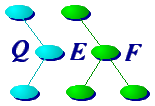
In this section we look at controlling a multi-directory application.




|
In this section we look at controlling a multi-directory application. |



|
|
First we need to chdir to the root of the object tree:
|
% qd -R / ; pwd # chdir to root of current tree Using 46 cook 3.4 object dt gobo linux2_0i /g/dt/cook/obj ... /g/dt/cook/obj treedirs: to create missing directories |
|
Then we need to create the tree for appl: % treedirs -a appl # create appl part of the tree + mkdir appl + mkdir appl/appl + mkdir appl/cmd + mkdir appl/lib + mkdir appl/man
qefdirs: The multi-directory script generator |
|
Now chdir into appl and look at the qeffile. % cd appl; cats qeffile Begin qefdirs All = Install Man # Bind All target to Install and Man appl I # appl has Install constructions lib IL # appl has Install and Local constructions + # '+' lines start new levels cmd IL lib # cmd depends on lib man m # m == Man, but only if @NO_MAN not set For this directory the script generator is qefdirs. This program will transform the above into a mimk script that provides a variety of selectable targets as listed by the following: % qef -Ptargets Local: do local constructions Local<N>: do local constructions for level <N> Install: do installations Install<N>: do installations for level <N> Man: install manual sections Man<N>: install manual sections for level <N> -D<Key>to=<N>: Specifies that <Key> actions up to level N done where <Key> is `I' for Install, `M' for Man, etc. -DDoto=<N>: Do up to level <N> <dir>~I: do Install for directory <dir> <dir>~<key>: do <key> action for directory <dir> RemoveObjs: remove objects created in current directory RemoveInst: remove objects installed into other directories RemoveAll: combine RemoveObjs & RemoveInst Any of above can be followed by `List' which suppresses removals and leaves list in place. All: implies: Install Man qefdirs levels |
|
In the current qeffile there are two levels. The qefdirs
flag % qefdirs -L Install 1 appl lib 2 cmd Man 2 man The division of the directory list into levels allows the user to select ranges of directories for selection which in larger projects can sometimes be useful. For example, if a compilation error in the 15th level causes a build to fail, the ability to restart the build suppressing the first fourteen levels can be a real time saver. The command to do that would be: % qef -DIto=14 # Installs done to level 14 The appl directory was created to illustrate a typical application package. Its directories are: appl # header directory lib # appl API cmd # the main programs man # the manual sections A Multi- Directory Project |
|
Despite the small size of this project, its qeffiles are representative of the qeffiles that would be used in similar directories in much bigger projects. The qeffiles are actually encoded to accommodate large numbers of source files. % lash -o 'cat `sls %1/qeffile`' `l -d` # see below + cat `sls appl/qeffile` set Suffixes h # limit sls to *.h files Begin # Install *.h files into destination's hdrs/appl/ instfls -d _DestDir_/hdrs/appl @argv~x/h/ + cat `sls cmd/qeffile` addpath LibPath ../lib # -lappl is in ../lib Begin program -v appl.c commands @argv @# Just in case we add any new files ... # Note that appl.c already processed above so not done again + cat `sls lib/qeffile` Begin library -v -n appl @argv @# Create appl library, add a lash is a command that interprets its first argument as a shell
command after replacing "%..." sequences by the remaining arguments in turn.
The l Multi-Directory Build |
|
Let's do the default build (i.e., Local): % qef # default build usually Local #{ @gobo 2003/07/20 05:17:25 # QEFHALTFILE: /g/dt/cook/obj/appl/%qef32208b.hlt #-{ -d lib Local @gobo 2003/07/20 05:17:25 New: /p/cook/s3.4/appl/lib/rtn.c Warning: "qmkhist._" does not exist -- all will be redone See warnMimk1(x-qmisc) + cc -c -I.. -I/p/cook/s3.4/appl -I/g/dt/cook/dest/hdrs \ /p/cook/s3.4/appl/lib/rtn.c + arupdate -V libappl -r libappl.a rtn.o - mkvernum -blib -o _vlappl.c libappl - cc -c _vlappl.c - /usr/bin/ar qv libappl.a rtn.o _vlappl.o a - rtn.o a - _vlappl.o - ranlib libappl.a - rm _vlappl.c rtn.o _vlappl.o #-} E0 gobo@/g/dt/cook/obj/appl/lib 2003/07/20 05:17:27(2) #-{ -d cmd Local @gobo 2003/07/20 05:17:27 New: /p/cook/s3.4/appl/cmd/appl.c Warning: "qmkhist._" does not exist -- all will be redone See warnMimk1(x-qmisc) + cc -c -I.. -I/p/cook/s3.4/appl -I/g/dt/cook/dest/hdrs \ /p/cook/s3.4/appl/cmd/appl.c + vcc -m appl -bdefl cc -o appl appl.o +VFILE+ wot version is it? |
|
The % wot lib/libappl.a cmd/appl # see below lib/libappl.a: Libappl 3.4(7) - 2003/07/20 05:17:27 - Linux-2.0.34-i686 cmd/appl: Appl 3.4(4) - 2003/07/20 05:17:29 - Linux-2.0.34-i686 Libappl 3.4(7) - 2003/07/20 05:17:27 - Linux-2.0.34-i686 The program wot is similar to SCCS's what. The version strings are embedded in libraries and programs prefixed by a "@(#)" string. mkvernum generated version strings |
| The numbers in parentheses after the release number (e.g., "(4)" and "(7)") are retrieved from the qdsrv database server. One of the databases maintained by qdsrv is a log of build numbers. On request, qdsrv increments the build number for the named module, records the request in the database, and returns the build number. Given the universal nature of the qdsrv, this number is unique across all platforms and users hence uniquely identifies the module. The record in the database also contains the host, directory, and user of the build thus using the build number and the qdsrv build record one can retrieve the information necessary to rebuild the module. These mkvernum generated strings (vcc is just a link to mkvernum) can take a variety of forms for use in arbitrary files. For example, the relinfo file in the root of the qef product tree contains in part: % cat $QTREE/relinfo Qtree(full) 9.1(57) - Linux-2.0.34-i686 - 2003/07/19 The Qtree and Tcl/Tk version lines were both generated by mkvernum. |
| cook22.qh - 1.19 - 03/10/24 |




|